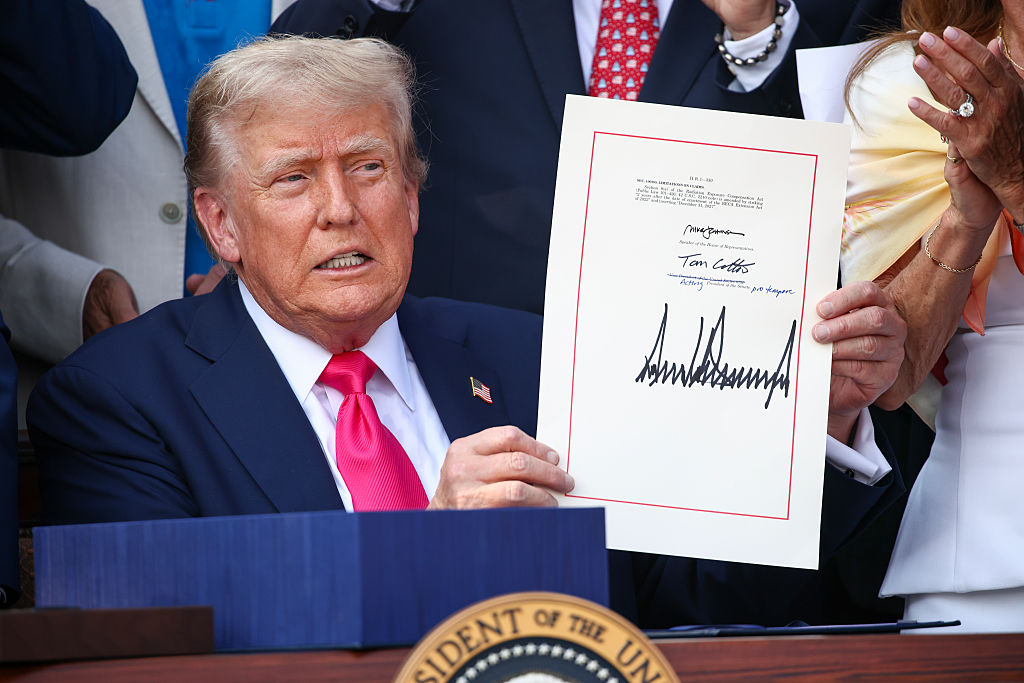What does Trump’s ‘Big Beautiful Bill’ mean for the US economy?
Donald Trump’s budget bill will slash taxes, but is expected to add at least $3 trillion to US national debt


US president Donald Trump signed his so-called ‘Big Beautiful Bill’ into law on 4 July, after the tax and spending package passed a final vote in the House of Representatives. The act extends tax cuts introduced during Trump’s first presidency, as well as introducing new measures.
Among other things, the bill increases standard tax deductions by $1,000 for individuals and $2,000 for married couples. Over-65s will also get increased tax breaks on their social security income.
US taxpayers will be given a bigger state and local tax (Salt) deduction allowance – increased from $10,000 to $40,000 for a period of five years. The Salt deduction allows taxpayers to reduce their federal tax bill by deducting state and local taxes, subject to certain limits.
MoneyWeek
Subscribe to MoneyWeek today and get your first six magazine issues absolutely FREE

Sign up to Money Morning
Don't miss the latest investment and personal finances news, market analysis, plus money-saving tips with our free twice-daily newsletter
Don't miss the latest investment and personal finances news, market analysis, plus money-saving tips with our free twice-daily newsletter
Tips and overtime were another area of focus. Workers can now deduct up to $25,000 in tips and $12,500 in overtime from their taxable income. These allowances will expire at the end of 2028.
The act also includes tax breaks for businesses, restoring some of the measures introduced in the 2017 package. Companies will be able to write off equipment and research and development costs in the year they are incurred. They will also be able to deduct the cost of building new manufacturing facilities.
Some households and businesses will be pleased to see their tax bills go down, but it comes at the cost of steep cuts to health insurance and social programmes. US borrowing is expected to rise significantly too, adding to the country’s eyewatering $37 trillion in national debt.
While Trump has slashed spending in certain areas, cuts do not come close to offsetting the cost of reducing taxes.
Cuts to spending on Medicaid, green energy and food benefits are expected to total around $1.7 trillion over the next decade, based on estimates from the Congressional Budget Office (CBO). By comparison, tax cuts are expected to cost $4.5 trillion.
Defence and border spending will be given an additional $150 billion and $100 billion respectively under the bill.
Overall, the CBO believes the ‘Big Beautiful Bill’ will add $3 trillion to US national debt over the next 10 years.
Can tax cuts be funded by tariffs – and will they boost US growth?
Trump has previously suggested that he wants to use tariffs to fund tax cuts. While tariff revenues will soften the bill’s effect on US debt, banking group Lombard Odier still expects debt levels to spike.
“Under the [bill] and including tariff revenues, the ratio of US debt held by the public to GDP is set to increase from today’s 100% to 119% within a decade, while under previous policies it would have reached 114%. Without tariff revenues, the budget would raise that ratio to 126% by 2034,” said Filippo Pallotti, macro strategist at the bank.
In other words, Trump’s bill will still push US debt levels higher.
“With little macroeconomic upside and a worsening fiscal outlook, we struggle to see anything beautiful about this budget,” Pallotti said. He doesn’t think tax cuts will lead to a consumer spending boost either. Trump’s extension of the 2017 tax cuts will not change current household cash flows, in his view, while the tips and overtime provision only affects a “small fraction of the population”.
Lombard Odier has not revised its US growth outlook in response to the bill, forecasting 1.3% GDP growth in 2025 and 1.4% in 2026.
Research provider Pantheon Macroeconomics is also sceptical about whether corporate tax breaks will unlock new investment for businesses – at least in the short term while tariff uncertainty is dampening business confidence.
“Investment plans were still depressed in June, even though the House signed off its version of the One Big Beautiful Bill Act in late May,” said Pantheon’s chief US economist Samuel Tombs. “All told, the bill will likely lift business investment in the medium term, but we expect firms to hold back from deploying their capital until the tariff outlook has clarified”.
Is US exceptionalism over?
Against a volatile backdrop, some investors have been asking whether US exceptionalism – a feature of the past decade and a half – is coming to an end.
The US dollar has fallen by around 10% this year as investors react against tariffs, rising debt and Trump’s erratic policymaking. US Treasury yields have also risen as investors demand a higher premium for buying US debt, a traditional safehaven.
Despite this, the S&P 500 soared to another record high last week. It took the index less than a month to recover the losses suffered at the start of April.
“The S&P 500 and tech-focused Nasdaq are once again trading at record levels, meaning the US is rapidly closing the gap with European stocks that emerged earlier in the year,” said Tom Stevenson, investment director at Fidelity International.
“There is a lesson here in not obsessing over rolling news but instead keeping an eye on the investment horizon.”
Despite this, analysts have pared back their estimates for earnings growth based on the tariff outlook.
Factset estimates published earlier this month suggest the S&P 500 achieved annual earnings growth of 5% in the second quarter. Back in March, analysts had been forecasting 9.4%. If the 5% estimate turns out to be correct, it would mark the lowest level of growth since the fourth quarter of 2023.
Not all analysts are overly concerned. Chris Beauchamp, chief market analyst at IG, points out that analysts always start optimistic before revising their forecasts down.
“What matters is that growth remains positive and meaningful. A 5% earnings expansion in today’s environment represents a genuine achievement, demonstrating corporate management’s ability to navigate challenges while maintaining profitability,” he added.
Analysts at global asset management firm BlackRock believe that US equities will “regain global leadership as the AI theme keeps providing near-term earnings support”, according to a July research note. Its investment institute remains “overweight” on US equities.
“We see scope for overall corporate earnings to stay solid, even if US growth is dented by tariff-induced disruptions and corporate caution,” its strategists said.
Get the latest financial news, insights and expert analysis from our award-winning MoneyWeek team, to help you understand what really matters when it comes to your finances.
Katie has a background in investment writing and is interested in everything to do with personal finance, politics, and investing. She previously worked at MoneyWeek and Invesco.
-
 Household savings ratio drops – are you setting enough aside for 2026?
Household savings ratio drops – are you setting enough aside for 2026?High inflation has pushed the savings ratio down again and the figure could dip further next year
-
 US stocks: opt for resilience, growth and value
US stocks: opt for resilience, growth and valueOpinion Julian Wheeler, partner and US equity specialist, Shard Capital, highlights three US stocks where he would put his money
